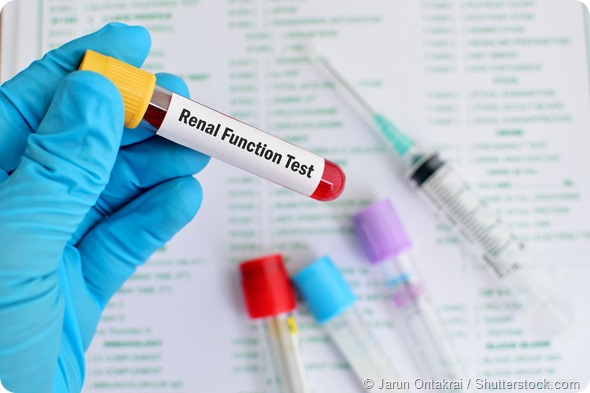Renal function tests are performed to evaluate how well the kidneys are doing their job of filtering out nitrogenous waste from the blood. They involve the measurement of various substances in both blood and urine in order to estimate the filtering efficiency of the kidneys. Chronic kidney disease (CKD) rarely produces any symptoms, until the critical kidney reserve is passed and kidney failure sets in. Therefore, assessment of renal function is important for early detection of CKD.

Importance of renal function tests
Renal function tests are important for:
- Early detection of renal disease
- Calibrating dosage of several drugs which are excreted or metabolized in the kidneys
- Indicating the appropriate time for the start of dialysis
- Evaluation of the renal status in both donors and recipients of heart and kidney transplants
An individual who is at risk for kidney failure is advised to have regular tests to pick up any deterioration in renal function. Risk factors include:
- Diabetes mellitus
- Hypertension
- Heart disease
- High cholesterol
- Age over 50 years
- A family history of renal failure
Renal function tests
Renal function tests are intended to provide an assessment of the glomerular filtration rate (GFR). GFR may be thought of as “the volume of plasma cleared of an ideal substance per unit of time”, expressed in ml/min, standardized to body surface area. To assess the GFR, a substance which is freely passed, unchanged, through the glomeruli and renal tubules, is used. A GFR of 60-89 ml/mi/1.73 m2 is considered to be normal.
Various methods are used to estimate the GFR. The most common method is an estimating equation based on the measurement of serum creatinine levels, using four variables related to age, sex, race and serum creatinine (the 4-variable modification of diet in renal disease formula). The estimated GFR is given alongside the serum creatinine in most laboratory reports. Either the estimated GFR, or serum creatinine levels are used to monitor renal function, for individual subjects.
Blood creatinine
Creatinine in the body is produced by the metabolism of the amino acids creatine and phosphocreatine, and a small amount is the result of meat ingestion. It is produced at a constant rate (±8%) provided renal function is conserved. It is freely filtered by the glomeruli, and is not reabsorbed, but up to 15% undergoes active secretion in the nephron. Therefore, it is close to being an ideal substance for GFR measurement.
Creatinine clearance
While formerly used to measure the GFR, creatinine clearance has now fallen out of favor because of the 24-hour period of urine collection required. This is so demanding that inaccurate collection volumes are the result. The measurements may also vary by up to 25%.
Creatinine clearance is calculated by the formula below:

While the active secretion of creatinine results in a falsely high urine creatinine, this error is stable and predictable, yielding an accurate picture of the GFR.
Blood urea nitrogen (BUN)
Urea is a waste product of protein metabolism. It is less consistent than serum creatinine levels in assessing renal function, as it is also affected by many other factors, such as a high intake of protein, corticosteroid treatment, muscle wasting diseases, or significant hemorrhage into the gastrointestinal tract. In addition, up to half the urea may be reabsorbed within the nephron, especially in the earlier stages of renal disease.
Radionuclide/radioisotope administration
Iothalamate radiocontrast or radioisotope injection may also be used to measure the GFR directly. These agents are administered as a single dose, followed by measurement of their plasma levels over time. The rate at which plasma levels decline reflects the GFR. A major disadvantage is the large increase in sampling times with advanced kidney failure. In addition, radioisotope use requires special precautions during handling and disposal, and is not suitable for pregnant subjects.
Urinary albumin
Albumin is a protein found in blood, and is normally not filtered into the urine. However, if the kidney is damaged, it allows some amount of albumin to escape into the urine. Other names for the test include:
- Urine protein test
- Urine albumin-to-creatinine ratio (UACR)
When the urine albumin is above 30, it could mean that kidney damage is present.
Mean urea and creatinine clearance
This measurement is used in patients receiving dialysis, to provide a picture of the remaining percentage of renal function. The mean of the urea and creatinine clearance is more accurate than either value individually, because the individual variations between the amount of urea reabsorbed and the amount of creatinine that is actively secreted compensate for each other.
References
- https://www.nlm.nih.gov/medlineplus/ency/article/003435.htm
- https://clinicaltrials.gov/ct2/show/NCT00026715
- Traynor J, Mactier R, Geddes CC, Fox JG. How to measure renal function in clinical practice. BMJ 2006; 333 (7571): 733–737
- http://nihseniorhealth.gov/kidneydisease/symptomsanddiagnosis/01.html
Further Reading
- All Renal disease Content
- Renal Disease and Skin Problems
- Renal Disease and Pregnancy
Last Updated: Aug 23, 2018

Written by
Dr. Liji Thomas
Dr. Liji Thomas is an OB-GYN, who graduated from the Government Medical College, University of Calicut, Kerala, in 2001. Liji practiced as a full-time consultant in obstetrics/gynecology in a private hospital for a few years following her graduation. She has counseled hundreds of patients facing issues from pregnancy-related problems and infertility, and has been in charge of over 2,000 deliveries, striving always to achieve a normal delivery rather than operative.
Source: Read Full Article
